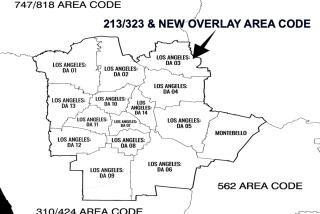PUC Study Sees Less Need for Adding Area Codes
- Share via
Only about half of all the phone numbers in Southern California’s 818 and 909 area codes and two Bay Area regions are being used, according to a study released Tuesday, giving state regulators more ammunition in their bid to delay the introduction of new area codes.
The study, conducted by the state Public Utilities Commission, doesn’t immediately change the telecommunications landscape in California. But it does show that recently enacted measures to conserve phone numbers can significantly delay the need for new area codes statewide.
“What this spells out is that there is a need to retool the system,” said Regina Costa, telecommunications research director at the Utility Reform Network, a San Francisco consumer group. “We don’t have to wake up and have a new area code every day.”
The PUC, spurred by growing public fury over the proliferation of new area codes, embarked on a statewide numbering study late last year after halting plans for all new codes, including ones in the works for 818, 909 and the Bay Area regions served by 415 and 510.
The report released Tuesday found that there was “no need for these area codes to be split or overlaid [with new codes].”
Each U.S. area code includes 792 assignable three-digit prefixes, and roughly 7.9 million phone numbers. In the 818, which covers the San Fernando Valley, the report showed about 3.9 million unused phone numbers, 1.2 million of which have not yet been assigned to phone companies. In the 909, which serves portions of San Bernardino, Riverside and eastern Los Angeles counties, there are about 3.9 million idle phone numbers, about 850,000 of which have not been assigned.
In the Bay Area, the 415 area code, which covers San Francisco and portions of Marin County, has 3.9 million unused numbers, including 1 million available for assignment. The 510 area code, serving the East Bay region, contains 4.3 million unused phone numbers, with about 1.5 million available for assignment to phone companies, the study found.
Earlier this year, a PUC study found about 2.9 million unused phone numbers in the 310 area code, which covers West Los Angeles and the South Bay. Uproar there over a new area code was the driving force behind the PUC’s new push for number conservation.
The PUC will complete similar studies for the state’s 20 other area codes by next July.
Phone companies contend that the state’s number-saving moves are unreasonable and thwart growth in the industry.
Part of the numbering chaos stems from the explosion in demand for phone numbers, which are used in everything from wireless phones and pagers to fax lines and automated teller machines at banks.
But the heart of the problem is the complex and inefficient way phone numbers are distributed to phone companies and other users. Under current rules, phone numbers are given out in full-prefix blocks of 10,000, no matter how many of those numbers are needed by customers.
That system has left millions of phone numbers unused and “stranded” at phone companies that have no immediate need for them.
California and other states are testing a new system that issues phone numbers in blocks of 1,000.
Last year, the PUC embarked on a strategy of doling out phone numbers more efficiently, forcing phone companies to track their usage more closely and--where possible--to return blocks of phone numbers that were not being used.
In addition, regulators ordered wireless and traditional “wired” phone companies to turn over detailed records of their phone-number inventories for each area code in California so that officials could keep track of number usage and prevent companies from stockpiling unused phone numbers for future use.
The focus on area code policy changes and conservation is a major shift for the PUC, which for years had approved a string of new area codes instead of looking for ways to make the numbering process more efficient.
Armed with data showing vast swaths of idle phone numbers, state regulators hope to win approval from the Federal Communications Commission to enact additional numbering policy changes to make more unused numbers available for use.
More to Read
Sign up for Essential California
The most important California stories and recommendations in your inbox every morning.
You may occasionally receive promotional content from the Los Angeles Times.













